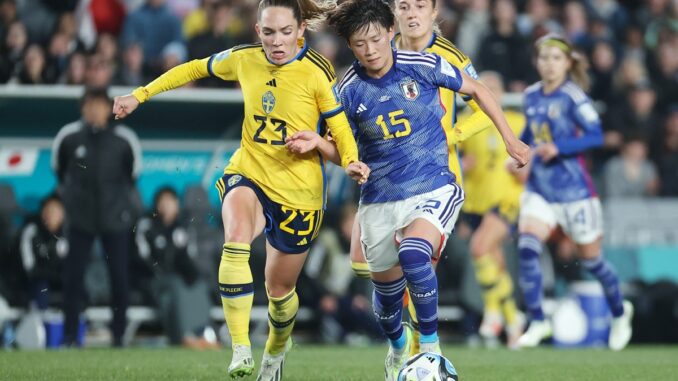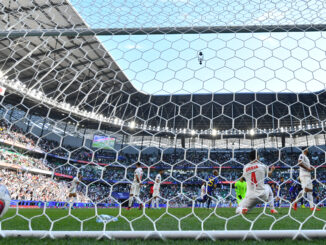

Japan’s campaign at the FIFA Women’s World Cup has reached its conclusion as the Nadeshiko produced a limp performance against well-organised Sweden team in Auckland.
Futoshi Ikeda’s side struggled to overcome a two-goal deficit and ultimately fell to the Scandinavians in a disappointing 2-1 defeat.
A quarter-final exit is Japan’s best finish at the tournament since reaching the final back in 2015. Whilst this team has shown much promise over the course of this campaign, an aching curiosity is left as to what might have been had they progressed to the semi-finals and, 3rd Place Playoff included, subsequently go on to play the maximum number of games at the tournament.
On the surface Ikeda appeared to have gone with a similar approach to that which proved effective in the 4-0 win over Spain. A slow-paced build-up allowing the Swedes to come on to them before launching a rapid counter seemed to be the order of the day. However, Sweden had come prepared and it quickly became clear that Japan weren’t going to catch an elite side off-guard a second time.
Sweden held the upper hand from the first whistle. Their organisation and synchronised pressing hindered Japan’s progress with the Scandinavians boasting numerical superiority in midfield. The physical mismatch was present for all to see and Futoshi Ikeda’s game plan appeared to be nullified and unfit for purpose early on.
If the warning signs hadn’t been there already, they certainly rang clear the 24-minute mark when Nathalie Björn caught the Japanese defence off-guard with a ball over the top from inside the Swedish half. Stina Blackstenius was quick latch on to the delivery and bore down on goal with Nadeshiko skipper Saki Kumagai doing little to prevent the shot which fortunately sailed wide of the mark.
Disaster struck amidst confusion in the Japanese penalty area following a free-kick just outside the penalty area. A muddled Nadeshiko backline failed to clear a loose ball which Sweden fired into the net at the third time of asking; Defender Amanda Ilestedt on the end of the final shot, claiming her fourth goal of the tournament.
This was by no means a goal of the tournament contender, but it was very much with the run of play until this point.
Sweden came close to doubling their lead just before half time when Kosovare Asslani’s effort was tipped onto the post by Ayaka Yamashita in what was an important save from the INAC Kobe keeper. Truth be told, Japan headed into the tunnel lucky to be trailing by just a single goal.
Alarm bells were ringing as Japan appeared void of ideas with an all too familiar series of events unfolding. Changes were needed and high performer Jun Endo was to replace Hina Sugita at left wingback for the remaining 45 minutes.
Misfortune reared its head for Japan soon after the restart as Liverpool’s Fuka Nagano was flagged for a handball when defending a Sweden corner kick. The decision was justified but harsh in that the central midfielder was jumping for a ball that was deflected onto her hand.
Filippa Angeldal calmly placed the spot kick in her left corner with Yamashita heading in the opposite direction, giving Sweden a 2-0 lead and leaving Japan with a mountain to climb.
With nothing to lose and Japan’s exit from the tournament a looming reality, the original gameplan of pragmatism and a slow buildup was discarded. At the 63rd mark Japan registered their first shot at goal and seemingly the Nadeshiko had found a new lease of life from here on.
Embed from Getty ImagesWE League top scorer Riko Ueki had come on to replace Mina Tanaka as the central striker and won a penalty for Japan as she was impeded by Madelen Janogy when breaking into the Swedish penalty area. Misfortune remained with Japan as Ueki stepped up to take the kick and fired it onto the crossbar with Swedish keeper Zećira Mušović beaten had the shot flown millimetres lower.
Japan’s late spurt produced viable chances from Jun Endo, Yui Hasegawa and Aoba Fujino who all came close to the mark. However it was defensive midfielder Honoka Hayashi who would offer hope when she found the net on 87 minutes. Japan had well and truly found a late foothold on the game and this was going to an uncomfortable 10 minutes of stoppage time for Sweden who had dominated much of the game.
Arguably Ikeda did not make a dynamic substitution that would alter the shape of the team until he brought on Sweden-based forward Maika Hamano for defender Hana Takahashi at the 92nd minute. The young Hammarby star made a significant impact and was a constant threat to the Swedish defence for the short time she was on the pitch.
Without question Japan had brought the game to Sweden and had found the confidence to ask serious questions of their robust defense. Sadly, it was too little too late and the whistle went with Sweden claiming what can only be described as a tactical victory over the former champions.
As a standalone performance this display will surely invite critique of Ikeda’s gameplan and squad selection. The Nadeshiko played with clear belief only when they were unshackled of the pragmatic approach and perhaps it would have been better to simply have let them play their way from the start.
Embed from Getty ImagesThe decision to start Hina Sugita over Jun Endo is also a curious decision and the lack of impactful substitutions until late in the game only leaves a lingering feeling of frustration.
Zooming out and considering the campaign as whole, however, we can only evaluate Japan’s showing at Australia and New Zealand 2023 as a clear indication that things are on the right track and the Nadeshiko once again sit at the table with the world’s best.
WHAT WE LEARNED
Doing it the “Nadeshiko Way”: Ikeda should be applauded for the tactical astuteness he has often shown during this tournament and prior to it. However, this match clearly did not showcase this and there is no other way to articulate it other than he got it wrong. Instead of a pragmatic, yet restrictive, approach he should have remained true to the principles of possession-based football and simply let the football flow.
The benefit of squad depth: Ikeda is blessed with an abundance of talent within the current Nadeshiko ranks. However, he has been somewhat sluggish with his substitutions and there has been little in the way of squad rotation. Hikaru Naomoto, Kiko Seike, Remina Chiba and Maika Hamano are a few examples of players that offer something a little different and it is disappointing that these players were not more involved across the tournament, fitness permitting.
Embed from Getty ImagesWHAT THEY SAID
Saki Kumagai
“The result is the result and it is disappointing to have lost this game. I thought it would be tough to turn this game around under the conditions we faced but we created plenty of chances and ultimately could have gotten back into it. I genuinely believe this team is yet to reach its full potential.”
Futoshi Ikeda
“It took some time for us to address the challenges that frustrated us during the game. We came out fighting in the second (half) and managed to get a goal back. I’m proud of the way we kept going and never gave up.”
WHAT COMES NEXT
Ikeda has expressed his desire to remain as Japan boss for the next major campaign. Paris 2024 is a little under a year away with qualification beginning in October and concluding in February 2024. This will be the next milestone of the Ikeda era.
The squad members will now return to their respective clubs and reassemble for international duty in September when they take on Argentina in Kitakyushu, Japan.
Listen to The Asian Game Podcast LIVE from the FIFA Women’s World Cup 2023




